Presented at the Second International Conference of Child Research Network Asia (CRNA) held in Tokyo, Japan, March 17-18, 2018.
Moderator: Christine Chen (President, Association for Early Childhood Educators, Singapore)
Presenters: Poh Tin Tan (Pediatrician, Tan Specialist Child and Family Clinic, Malaysia), Thelma Mingoa (Assistant professor, De La Salle University, the Philippines), Masahiro Oba (Director, Yoko Fukushikai [Welfare Organization]; Principal, Taiyo-no-ko Hoikuen [Daycare Center], Japan)
Chen: In this concurrent session, Dr. Tan from Malaysia, Professor Mingoa from the Philippines, and Principal Oba from Japan will each deliver their lectures in turn. The fundamental concept of "special needs" will be addressed as well as the issues and solutions required to support such needs. After the presentations, there will be a Q&A session with the audience.
Dr. Tan, please start your lecture.
Special needs of children with "Adverse Childhood Experiences" (Poh Tin Tan)
Tan: It is important to fully evaluate the needs of each individual child, in order to provide them with the appropriate support for their respective needs. The special needs of children with autism, ADHD or other medical/emotional disorders are relatively easy to discern and specific support measures have been discussed by earlier speakers and can be implemented for them.
However, there is still a large number of special needs which are likely to be overlooked if we do not carefully observe and identify the child with such need. Hence, the necessity of support for such needs is often ignored. Today, I will discuss "Adverse Childhood Experiences (ACE)," one of the special needs that have frequently been ignored, from the perspectives of brain science and neuroscience.
ACEs are traumatic events such as household dysfunction and abuse.
First of all, we will examine how many people have experienced ACEs.
From 1995 to 1997, the CDC-Kaiser Permanente Adverse Childhood Experiences (ACE) Study surveyed 17,000 Health Maintenance Organization members from Southern California. The confidential, self-completed questionnaire asked whether they had experienced any of the 10 ACE items including household dysfunction (drug abuse; separation or divorce of parents; domestic violence against mother, had a member of household in prison), abuse or neglect in their childhood. The survey revealed that about 13% of the respondents had experienced four or more ACE. 64% experienced at least one or more ACE, and about 21% experienced sexual abuse. This study on insurance members from medium-income households revealed that ACEs are not simply problems which affect only the economically disadvantaged.
The respondents who had experienced four ACE items or more tend to report more sexual activities, sexually transmitted diseases, pregnancy in their teenage years, as well as obesity, suicide attempts, depression, and domestic violence.
The Behavioral Risk Factor Surveillance System Survey was conducted in 2011 on 48,526 adults from 5 states in the USA. A total of 55.4% of respondents reported at least one ACE and 13.7% reported four or more ACEs. The results were similar to those obtained 15 years ago, indicating that the situation had not changed.
One Malaysian university asked 300 students attending a social science class to complete an anonymous questionnaire on their personal experience of sexual and physical abuse. About 10% of the students replied they had been sexually abused by a family member. I was taken aback by the number of victims, which was far beyond my expectation. Victims of abuse often fear being stigmatized as socially deviant, etc. and are reluctant to report to the authorities.
Research has shown that adversity may transfer from one generation to the next in the form of abuse/neglect, housing risk, and poor socioemotional health. Additionally, mothers' history of adversity is associated with depressive symptoms before and after giving birth, and with their infants' maladaptive socioemotional symptoms. This generational pattern of ACEs is not just socio-environmental, but is now thought to be transmissible through epigenetic changes in the mother's genes as she experienced ACEs from early childhood.
Therefore, we should carefully check whether young children have ACEs and if any, intervene in a timely and appropriate manner so as to interrupt the transmission to the next generation. The intervention of adults is particularly important for children in early childhood because experiences and adverse circumstances significantly affect the development of their brain at this stage.
There is a sensitive period for learning (window period) in the development of the brain. For example, it is generally known that experiences and circumstances have a determining influence on the acquisition of the first language (mother tongue) for children aged one to three years, the acquisition of the second language for children aged five to seven years, and the acquisition of music skills for children up to seven years of age (Figure 1). It is also said that a child's first five years are critical to the development of various skills and abilities such as controlling of emotions and understanding of mathematical concepts. Therefore, the supportive intervention of adults is important for pre-school children. Teachers have an absolutely crucial role in understanding and supporting the special needs of children including those with ACEs. The support of adults who consistently love and look out for a child will ensure the normal development of the child even if the child's family has numerous problems.
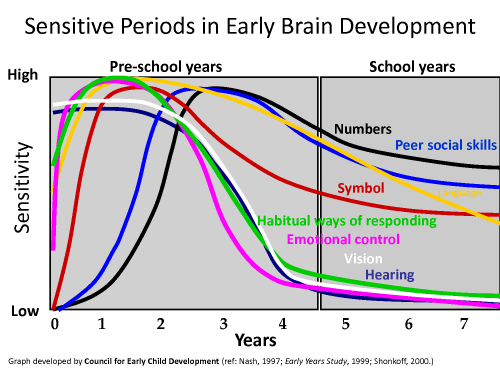
Figure 1
Learning music (especially a musical instrument) during the first seven years of life can have positive effects on the development of the brain. This is because children learn music with their whole body, not just their eyes and ears. This stimulates the right and left hemispheres of the brain as well as the corpus callosum connecting them, developing new neurons and networks and interconnectivity.
Furthermore, while learning to play a musical instrument, the child learns to accept the frequent correction by the teacher and keeps imitating the correct technique, however frustrating. They learn that skills acquisition and mastery comes with practice, and not giving up! The acquisition of musical skills after constant practice brings a sense of accomplishment and confidence which makes them better learners in other fields.
It is also necessary to reconsider the methods of assessing children to support their development. The conventional assessment method based on "what cannot be done" has several advantages such as setting goals for each child and making an appropriate intervention at the early stage. However, this method only indicates "what a child cannot do at the moment". As each child has his or her own pace of learning, "what a child cannot do at that moment" should not be interpreted being the same as "what a child will not be able to do in the future." It is important for children to work towards achieving their goals even if they take a longer time than others. Adults should understand such individual variability in developing skills and abilities. Therefore, it is necessary to employ not only the assessment method based on "what cannot be done" but also other methods to evaluate children's abilities from a long-term perspective.
As the studies on ACEs indicate, there is potentially a great many children who have special needs who are often overlooked. These hidden needs affect the various aspects of children's daily life, including their learning progress and prognosis.
Therefore, whenever a teacher finds a child who seem to have learning challenges, he/she should carefully look for hidden adverse causes, for example, by interviewing the family and fully understanding the child's environment. In this way, it becomes possible to ascertain the true cause and take appropriate supportive measures early.
Chen: Thank you very much. Dr. Yoichi Sakakihara, CRN Director, is attending this session. Dr. Sakakihara, please provide your comment on Dr. Tan's lecture.
Sakakihara: Dr. Tan gave us inspiration about the education of children with special needs from various aspects. For example, the method of assessment is critical. As she explained, assessing children in a rigorous way will not save children with special needs but will leave them with things troubling them. She also emphasizes the role of adults. I think, not only the role of teachers involved in early childhood education, but also the role of elementary school teachers is important. It is necessary to interact closely with each child, find those with ACEs and provide them with sufficient support.
Developing the social and emotional skills of children with special needs and realizing a better inclusive education system (Thelma Mingoa)
Mingoa: I will discuss the education of children with special needs focusing on two aspects, taking practices in the Philippines as examples.
First, we should help teachers of regular classes deepen their understanding of children with special needs. Students taking a teacher training course at Philippine universities are required to take the subject of inclusive education as well as the subject of special needs education. There are some teachers of regular classes who become perplexed at inclusive education. Therefore, it is necessary to provide them with opportunities to receive on-site learning and interact with doctors, community members and other related people outside their university to obtain more practical, specialized knowledge regarding children with special needs. In addition, it is important to advocate that inclusive education is beneficial to both children with special needs and those without.
Second, we should develop the social and emotional skills of children with special needs. According to a research study on children with special needs, it is revealed that their social and emotional skills are extremely limited regardless of their age, sex and the type of disability. Nevertheless, there are a great number of children with special needs who may have the potential to obtain social skills and control their emotions.
For example, a research study conducted at a school in Hong Kong used social stories (generally used in rehabilitation for children with autism) as an intervention tool to help children with ADHD. A social story was created for each child, according to their problem, and read to the child repeatedly every day during the research period. A storybook was put together for children with particular problems such as those who would make an outburst when not called on by their teachers or jump off chairs. The book was intended to help them learn how other people would think about their behavior, how their behavior would affect other people, and how other people would handle each situation. This intervention tool successfully reduced the incidence of problematic behavior.
As Dr. Tan previously explained, ACEs such as abuse will trigger special needs. According to a research survey targeting children aged four to five years in poor families in the Philippines, it is revealed that adults' appropriate intervention can develop children's abilities to protect themselves, including the abilities to say no to what they do not want (self-assertiveness), express their emotions, and identify adults whom they can rely on. Such abilities are necessary for children to protect themselves when, for example, they are bullied in a classroom.
As the above examples show, appropriate support for children with special needs can help them enhance their social and emotional skills. Therefore, in order to provide support to children with special needs so they can accommodate themselves to regular classes, it is fundamentally necessary to support their learning. It is also necessary to provide educational programs so that their peers and teachers may understand such children. Furthermore, it is important to prepare specific programs that support children with special needs to learn how to control their behavior, self-awareness, decision-making, and social cognitive skills and establish a personal relationship with other people.
Chen: Thank you very much. I believe that it is important to provide appropriate support and create a climate of respect and acceptance for children with special needs. In this way, they become part of the learning community and develop the sense of belonging. This sense of belonging is essential in building citizenship and participation for all children in classrooms. It is our hope that such inclusive classrooms be made available to children with special needs in every country. Does anyone have any questions or suggestions?
Sakakihara: As a pediatrician, I have been involved in children with autism or ADHD over the years. I often noticed that Japanese kindergartens and daycare centers treated these children by simply prohibiting their problematic behavior. I think it is very important, considering the direction of special needs education we should seek, to provide more positive support for children with special needs so as to help them protect and accommodate themselves to their class.
Questioner A: I am a teacher in Singapore. I believe that the application of flexible approaches to children could be a key for successful education in the 21st century. It is important to establish an educational philosophy valuing the diversity of children, instead of sticking to the conventional mindset of requiring all the children to pursue the same goal, teaching "you should be able to do it" or "you should be able to follow what the teachers say." This will contribute to the realization of ideal inclusive education.
Tan: To improve the inclusive education system, it is necessary to consider the class composition as well. If two or three children with special needs are allocated to a class of forty students, it may be difficult for a single teacher to provide adequate support for them. We must consider the necessity of increasing the number of teachers or reducing the number of students in a class. We should also develop a new approach to determine the grade of placement of children based on different criterion (such as the degree of development) instead of their age.
Chen: In this regard, cultural differences may be involved, apart from educational systems. One of the participants from Indonesia told me that there was no problem at all in allocating two or three children with special needs to Indonesian regular primary schools. Their peers warmly supported these children. He said this was because of the warm and open culture where children are accepted and loved for who they are and for the strengths that they bring into the classroom. It may be difficult to accept such a phenomenon in a school system or a culture where it is more structured, inflexible and competitive How is it like in the Philippines?
Mingoa: I don't think this is a big problem in the Philippines either. Philippine public schools are currently introducing an inclusive education system based on the principle of accepting the diversity of children. These schools adopt flexible approaches to maximize the abilities of children. It is also true that some teachers are calling for certain guidelines due to the broad flexibility. Certain primary schools also adopt a flexible grade system in which students in their fourth year or above can take a class of higher grade if they achieve excellent academic performance, or take a class of lower grade if they have any problem in academic performance.
Questioner B: I once visited a preschool education facility in a European country. It had introduced a seamless education system, in which children are not allocated to classes according to their age. I was surprised at how freely the children were able to learn from each other. Chen: It seems that warm, receptive attitudes and flexible education systems are critical to developing an inclusive education system.
Shifting from "special childcare" to "regular childcare" that is beneficial to all children (Masahiro Oba)
Oba: As a childcare worker, I will discuss special needs education in Japan.
First of all, I will describe the current conditions in Japanese daycare centers with special reference to the issues of special needs education. Since 1978, the government has provided subsidies to general daycare centers in order to increase the number of caregivers according to the number of children with disabilities. This policy enables these daycare centers to officially accept such children. Currently, most daycare centers have an allocation ratio of one caregiver to every three children with disabilities. Some parents may expect these allocated caregivers to have a certain level of expertise in special needs education; however, the qualification of childcare workers in Japan does not require knowledge of this special category. As a result these allocated caregivers generally have no such expertise. All students who take the childcare worker training course are required to obtain two credits in the "Special Needs Nursing" program. Other than that, it is up to each individual student or childcare worker to obtain further knowledge and skills if they so desire.
In the same year, the Health and Welfare Ministry announced the notice of "Acceptance of Children with Disabilities in Daycare Centers," stating the policy that "childcare for special needs children attending daycare centers should be offered through mixed care with and without special needs considering thoroughly the features of children with special needs." Since then, the concept of "integrated childcare" has been introduced, which encourages no distinction between children with or without disabilities and allows them to learn and play in the same place.
Integrated childcare is implemented based on the assumption that children can be classified into two categories, of children with and without disabilities. This concept is beneficial to both children with and without disabilities because children with disabilities can get a broader experience and promote their skills for independence and cooperativeness, while children without disabilities can gain understanding of disabilities and so develop a caring mindset. Therefore, integrated childcare is considered as "special childcare" that has different advantages for both groups of children.
It should be noted, however, that the classification of children with disabilities requires careful consideration because the threshold to determine which children have characteristics that are significantly different from normal is quite ambiguous at the stage of early childhood when the pace of development varies between children. Even if such a threshold is appropriately established, this may bring up various issues as the threshold itself will tend to generate dichotomy between children with and without disabilities.
Concerning the current conditions of integrated childcare, children with and without disabilities are separated in different childcare environments and curriculums even though they are allocated to the same class. They participate in activities together only when possible (Figure 2). It seems that the purpose of integrated childcare is not achieved. Furthermore, this will cause children with disabilities to interact with the allocated caregiver only, and consequently, have a closed relationship with the caregiver. It is also difficult to share the knowhow to support children with disabilities within the daycare center. If the allocated caregiver is transferred or displaced, difficulties will be encountered in trying to provide continuous support.
Figure 2
Therefore, I believe that, it is necessary to establish a childcare environment that values the diversity of children and allows caregivers to support each child according to their needs, instead of classifying children with special needs (Figure 3). This helps to realize true inclusive childcare and also to convert integrated childcare from "special childcare" to "normal childcare," instead of changing to a "more special inclusive education."
Figure 3
To arrive at specific solutions, I continuously visit daycare centers in Finland, a leading country for inclusive childcare. Gradually, I came to the conclusion that there are two important factors in the realization of inclusive childcare. One is to establish a "basic environment" where the awareness, knowledge, and skills of caregivers are cultivated and the curriculum of childcare is prepared based on the diversity of children. The other is to provide "reasonable accommodations" for each child. Although Japan's conventional childcare system emphasizes reasonable accommodations, the establishment of a fundamental environment has not been properly discussed. I became conscious of the importance of a fundamental environment after observing the conditions in Finnish daycare centers. Based on such an environment, reasonable accommodations should be incorporated.
Here, I will explain some measures which are currently undertaken in my daycare center.
To establish a basic environment, we provide a "resource space" where a child can be alone and calm himself or herself (Figure 4). Not only children with special needs but any child can freely use the space. We also prepared the curriculum incorporating several plays focusing on sensory integration. As you see, all children regardless of their needs enjoy these types of play very much (Figure 5). To provide further training for childcare workers, we invite professionals such as researchers and occupational therapists specialized in sensory integration once or twice a month.
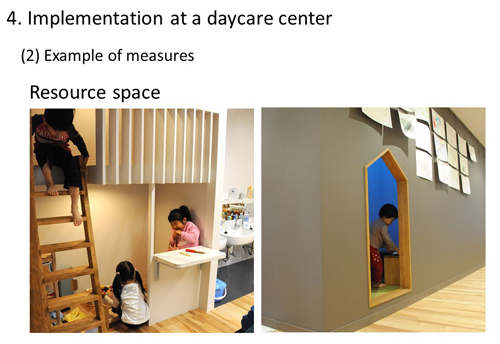 |
||
| Figure 4 | Figure 5 |
To provide reasonable accommodations for children, for example, we provide headphones that reduce extraneous noise in the classroom for children who are sensitive to sounds. Since everyone is at liberty to use these headphones, we often see children without special needs using them to concentrate on building a jigsaw puzzle, etc. In addition, we usually notify the whole class of regular notices such as the daily schedule, while also individually explaining it to each child with special needs to make sure that they fully understand. However, three or four months after their enrollment, most children with special needs become able to understand the notices when the whole class is informed, making such individual notices unnecessary.
What my daycare center is aiming for is to establish a childcare environment where one can "lead an easy life for children with special needs," while it is also a "friendly environment for everybody."
The pace of development varies depending on each child. The principle of childcare supporting children according to their characteristics is very important. By expanding the range of such support step by step, I believe that it is possible to establish an environment widely open for children with special needs.
Chen: Thank you very much. Does anyone have any questions or suggestions?
Questioner C: As you explained, integrated childcare provides children with disabilities and children without disabilities with different advantages. I think it is important to provide the same advantages for all children to realize inclusive childcare. What do you think?
Oba: I completely agree with you. For this reason, my daycare center is working to prepare a childcare environment to offer the same advantages to all children, such as the establishment of the resource space as I explained.
Questioner D: I have a two-year-old child with orthopedic impairment. I am now thinking about putting my child in a daycare center. As you say, students who take the childcare worker training course are required to obtain only two credits in the "Special Needs Nursing" program. I think there must be some childcare workers who lack confidence when they are working with children with special needs. What do you think, what kind of training do they need?
Oba: In my daycare center, we are trying to gain the understanding of caregivers so that "they can support children with special needs even though they do not have special knowledge and skills." The principle of childcare supporting children according to their characteristics will remain the same regardless of the existence of special needs. Caregivers have many things they can do even though they do not have expertise in special needs education, such as understanding of the condition of each child and sharing of information with parents. We also try to enhance collaboration among caregivers by hosting a regular meeting where all caregivers including myself can discuss matters, for example, or setting a personal interview with parents to encourage caregivers to cooperate with parents in supporting children.
It is very important to ensure communication takes place between caregivers and parents, because parents are the ones who understand their children the most. My daycare center allows caregivers to accompany a child and his/her parent to a hospital and consult a doctor together if necessary. In this way, we hope to provide personal support for children in the same way as their family does.
Chen: Most people would think that special qualifications and expertise are necessary for special needs education. However, I believe that the most important thing is to recognize the children with special needs as a child first; A child like any child who would need to be loved, respected, feel belonged and acknowledged for what he/she can bring into the class. As early childhood educators, we can respond to the child, recognize the contributions he/she brings and consult other specialists like doctors and occupational therapists to help him/her overcome his/her special challenge.
Questioner E: I am engaged in the management of a daycare center and the education of childcare workers. Could you please tell me if there are any expectations for childcare worker training schools in the future?
Oba: I hope that childcare workers can get more opportunities for learning.
In European countries including Finland, it is common that people, who work as childcare workers to gain experience for a certain period of time, take a leave of absence and attend university to get credits in special needs education. Then, they go back to the daycare centers and leverage their expertise. In contrast, Japanese people tend to encounter difficulties in getting opportunities for proper learning once they are employed. In my case, I attended the seminar of Professor Sakakihara, one of the adult education programs at Ochanomizu University once a week for two years. It was very hard for me to squeeze in time to study, but by doing that I was able to deepen my understanding of childcare.
Mingoa: In the Philippines, we often see not only students but also adults such as childcare workers and teachers taking part in special needs education programs at schools. They are studying to deepen the understanding of their students.
Tan: I think we should promote an environment where working people can learn more freely. With the current advances in information technologies and easy access, working adults should be able to take accredited online courses whenever they have time, instead of having to attend lectures at a physical venue. I hope graduate schools will adopt a flexible education module to give more opportunities for working people to continue learning and to acquire specialized training on line.
Questioner F: My second son has special needs. This made me learn about disabilities and rehabilitation. Please tell me your thoughts about the relationship between social and emotional skills and the establishment of a basic environment.
Oba: The establishment of a basic environment is absolutely critical to helping children obtain social and emotional skills. For example, some children with special needs cannot control their emotions when they feel panicked. In this case, it is important to provide an environment for such children to help them recognize their panic state and calm themselves. As I mentioned previously, the resource space was created for such purposes. If children can utilize the environment to fight back panic, they will gradually acquire the skill of controlling their emotions. It is also important to provide the environment by taking special care not to damage their self-esteem, because children with special needs often have difficulty in maintaining their self-esteem. Therefore, in my daycare center, we are working to create an environment that can be used by all children, instead of providing an environment specifically for children with special needs.
Chen: Today's discussions have been very thought provoking and inspiring. Since all of us in this session are passionately seeking better solutions for children, I am sure as we return to our practice in different parts of the world, we will be able to make a difference in the lives of children with special needs in typical developing classrooms. Before closing this session, I would like to assure everyone that each one of us is special in our own way and that it is our responsibility to find out what is the specialty of each child and walk his/her journey with him or her. Thank you very much for your kind attention.



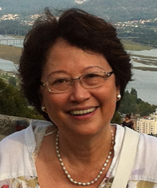 Chiristine Chen
Chiristine Chen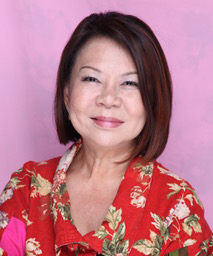 Poh Tin Tan
Poh Tin Tan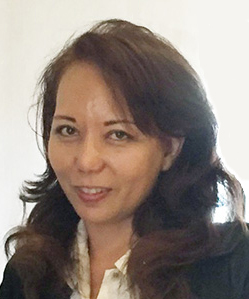 Thelma Mingoa
Thelma Mingoa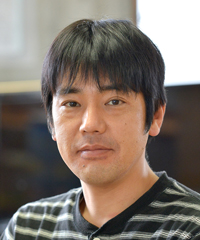 Masahiro Oba
Masahiro Oba










